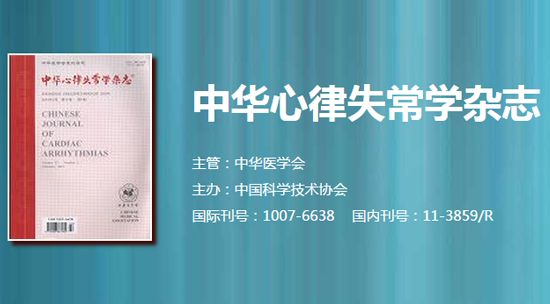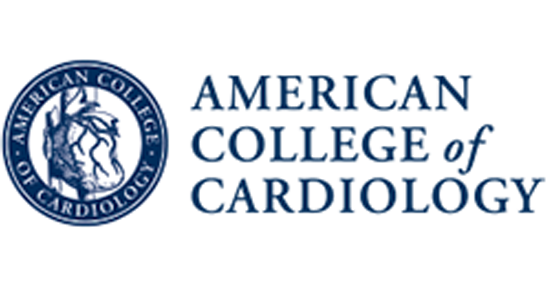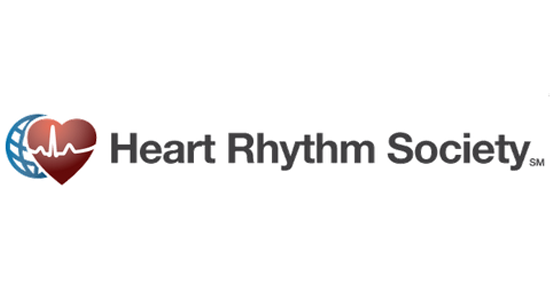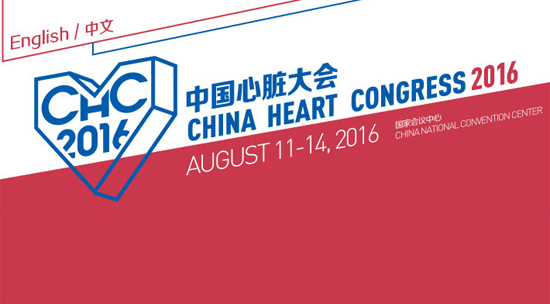Heart Rhythm主编—陈鹏生教授语音速递(六月刊 英文版)
<< First issue in June 2019 >>
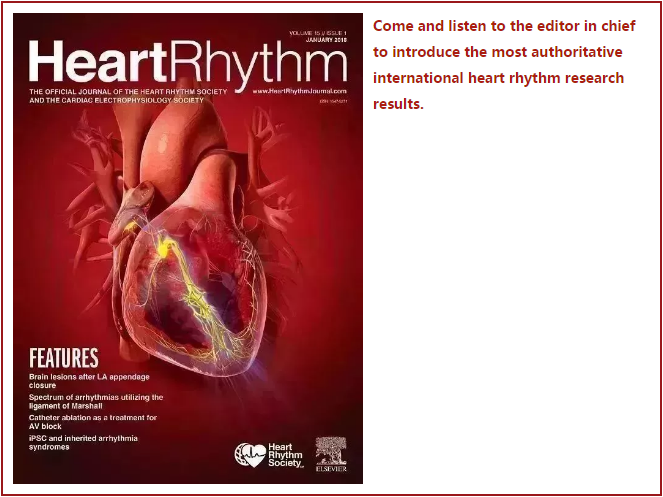
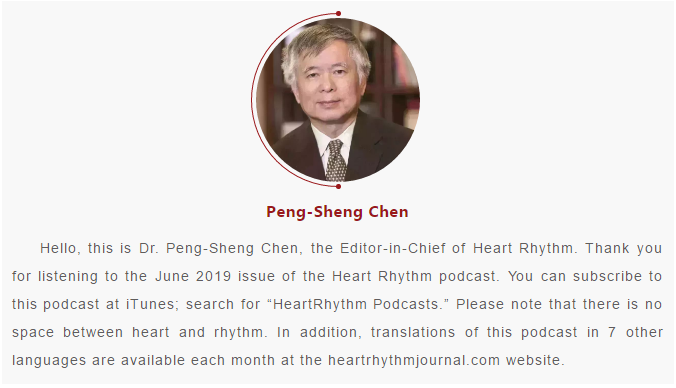
1
The featured article this month is an original article titled “Arrhythmic burden among asymptomatic patients with ischemic cardiomyopathy and an implantable cardioverter defibrillator” by Sabbag et al. from Davidai Arrhythmia Center, Israel. An accompanying video author interview conducted by our online editor, Dr. Daniel Morin, can be found at the www.heartrhythmjournal.com website. The authors used a prospective national ICD registry to examine the benefit of primary prevention ICDs in patients with NYHA class I symptoms. They found that, after adjustment for the competing risk of death, patients with ischemic cardiomyopathy without heart failure symptoms have a higher risk of appropriate ICD therapy compared with symptomatic patients, suggesting possible incremental benefit of primary ICD implantation in the asymptomatic population. While this study was limited by the absence of a control group, these findings suggest that asymptomatic patients with ischemic cardiomyopathy might benefit from ICD implantation even more than their symptomatic counterparts.
2
Claxton et al from Emory University wrote the next paper, titled “A New Model to Predict Ischemic Stroke in Patients with Atrial Fibrillation Using Warfarin or Direct Oral Anticoagulants”. They studied 135 thousand patients with AF who initiated oral anticoagulants, and analyzed 44 candidate variables including comorbidities, procedures, pharmacy fills, and demographic characteristics. While 11 of these variables were associated with stroke, their predicative value was not better than the established CHA2DS2-VASc score. These results offer support to the current recommendation to use the CHA2DS2-VASc score to evaluate ischemic stroke risk.
3
Next up is a paper by Tsuda et al from Kanazawa University, Japan, titled “Impact of Hypertrophic Cardiomyopathy on Prediction of Thromboembolism in Patients with Non-valvular Atrial Fibrillation”. The authors studied over 2000 Japanese patients. They found that hypertrophic cardiomyopathy is an independent risk factor for thromboembolism in patients with non-valvular AF. A markedly high incidence of thromboembolism was observed in hypertrophic cardiomyopathy patients with all CHA2DS2VASc scores. These results reconfirm the current American and European guidelines that support the initiation of anticoagulation in patients with hypertrophic cardiomyopathy and atrial fibrillation, regardless of CHA2DS2VASc score.
4
The next article is titled “Propensity-Matched Comparison of Cryoballoon and Radiofrequency Ablation for Atrial Fibrillation in Elderly Patients” by Takashi Ikenouchi et al from Japanese Red Cross Saitama Hospital. They studied 305 patients aged >75 years who underwent PVI, and followed them for 12 months. They conclude that the efficacy of PVI with a cryoballoon might be comparable to that of PVI with radiofrequency ablation and involves a shorter procedure time. Because elderly patients are often excluded from randomized clinical trials of cryoballoon ablation, these data are useful to confirm the efficacy of that approach in elderly patients.
5
Liang et al from University of Pennsylvania wrote the following paper titled “Safety and Outcomes of Catheter Ablation for Atrial Fibrillation in Adults with Congenital Heart Disease: A Multicenter Registry Study”. The authors examined 84 congenital heart disease patients undergoing AF ablation, with 1 year follow up. Overall, complete freedom from AF was achieved at 1 year in 53.1% of patients. The authors conclude that in spite of the dramatic differences in the degree of congenital heart disease complexity, AF ablation is both safe and effective in these patients. These findings indicate that patients with complex congenital heart disease may still benefit from AF ablation in highly experienced centers.
6
Next up is a paper titled “Association of mechanical bradycardia and post-extrasystolic potentiation with premature ventricular contraction-induced cardiomyopathy.” by Billet et al. from University Hospital Rangueil, Toulouse, France. Invasive arterial pressure measurements from 17 patients with PVC induced cardiomyopathy and 16 controls with frequent PVCs were retrospectively analyzed. PVCs were considered “efficient” or “ejecting” when they generated a measurable systolic arterial pressure. The authors found that the number of ejecting PVCs divided by the total number of PVCs was 29% in PVC-induced cardiomyopathy, and 78% in controls. They conclude that patients with PVC-induced cardiomyopathy have more non-ejecting PVCs compared to controls. Based on these data, the authors propose that concealed mechanical bradycardia due to hemodynamic inefficiency of PVCs might contribute to the development of PVC-induced cardiomyopathy.
7
Yang et al from the Hospital of the University of Pennsylvania wrote the following article titled “Outcomes of Simultaneous Unipolar Radiofrequency Catheter Ablation for Intramural Septal Ventricular Tachycardia in Non-Ischemic Cardiomyopathy”. Following failed prolonged sequential unipolar RF lesions, simultaneous unipolar RF was delivered using two open-irrigated catheters at the site of earliest activation and/or best entrainment or pace-mapping, and also at an anatomically adjacent or opposite site. Out of the 6 patients attempted, 4 remained arrhythmia free at 20 months. These findings suggest that simultaneous unipolar RF ablation is a safe and effective alternative ablation approach to improve long-term VT control in patients with intramural septal VT that is refractory to other ablative techniques.
8
Next up is a paper by Mendelson et al. from Penn Presbyterian Medical Center, titled “Feasibility of Complex Trans-Femoral Electrophysiology Procedures in Patients with Inferior Vena Cava Filters.” The report included 50 complex ablation procedures in 40 patients. Among them, only 3 patients had an occluded IVC filter that could not be crossed. Therefore, the presence of an IVC filter should not discourage operators from performing procedures that require trans-femoral deployment of multiple catheters and/or sheaths.
9
Salghetti et al from Brussels, Belgium wrote the following article titled “Hybrid thoracoscopic epicardial ablation of right ventricular outflow tract in patients with Brugada Syndrome.” In their protocol, the electrophysiologists analyzed the electrograms, while the surgeons performed ablation in 36 patients. After 16 months of follow up, freedom from ventricular arrhythmias was achieved in three-quarters of secondary prevention patients, and all primary prevention patients. These finding indicate that hybrid thoracoscopic epicardial ablation under direct visualization is safe and feasible, with good outcomes. However, the authors note that ICD implantation is still mandatory in secondary prevention and high risk patients.
10
The next paper is titled “Ablation Index as a predictor of long-term efficacy in premature ventricular complex ablation: a regional target value analysis” by Casella et al from Milano, Italy. The ablation Index is an index incorporating contact force, time, and RF power simultaneously, and it is used to predict lesion size and outcomes in atrial fibrillation RF catheter ablation. The authors now apply this index to 135 patients with idiopathic outflow tract PVCs. They found that ablation index was higher in the ablation success group than ablation failure group. These data suggest that the ablation index could predict the success of PVC ablation. Prospective studies will be needed to further test that hypothesis.
11
Hai et al from Queen Mary Hospital, the University of Hong Kong wrote the next article titled “Safety and Feasibility of a Mid-Septal Implantation Technique of A Leadless Pacemaker”. A major risk of implanting leadless pacemaker at the right ventricular apex is cardiac perforation. This study included 51 high-risk patients. Among them, 29 were >80 years old, 7 had body mass index <20 kg/m2, 48 had renal dysfunction, and 33 had valvular heart disease. In this cohort, mid-septal implantation of a leadless pacemaker as guided by fluoroscopic RAO, LAO and left lateral views was achieved in 90% of patients with a low rate of complications. The pacing threshold remained stable at 200 days of follow up. Adopting the septal implant technique may reduce the complication rates among high risk patients.
12
The next paper is titled “Syncope, conduction disturbance, and negative electrophysiological test: predictive factors and risk score to predict pacemaker implantation during follow-up.” by Roca-Luque et al. from Barcelona, Spain. The authors included 159 consecutive patients with syncope and bundle branch block but negative EP studies. All patients received an implantable loop recorder. After 2 years of follow up, one of every 4 of these patients needed a pacemaker for bradycardia. In the multivariate analysis, only bifascicular block and HV interval >60 ms were statistically significant predictors for pacemaker implantation. Most importantly, this “wait and see” approach resulted in no death or severe trauma related to bradyarrhythmia.
13
Next up is a paper by Miwa et al. from Japanese Red Cross Musashino Hospital, titled: “Impact of Diurnal Variations in the QRS complex and T-waves on the Eligibility of Subcutaneous Implantable Cardioverter-Defibrillators.” They analyzed 24-hour Holter monitoring in 86 patients in order to assess S-ICD eligibility. The results showed that a quarter of the patients with a transvenous-ICD who initially appeared eligible by conventional and exercise screening ECGs were declared ineligible for S-ICD when Holter monitoring revealed tracings that could result in malsensing by the S-ICD. The detection of diurnal variations by Holter monitoring in addition to conventional screening is expected to be useful for determining S-ICD eligibility. This approach is particularly applicable to patients with increased QRS duration or those with Brugada syndrome.
14
Hattori et al, from Yokohama Rosai Hospital in Japan, wrote the following paper titled “Prognostic Impact of Lead Tip Position Confirmed via Computed Tomography in Patients with Right Ventricular Septal Pacing.” The authors retrospectively enrolled 228 consecutive patients with AV block. Using the CT scan, the patients’ RV lead tip positions were classified as septal versus free-wall. Multivariate Cox regression analysis demonstrated that the lead tip in the free wall was an independent predictor of cardiac death and heart failure hospitalization. These studies suggest that RV lead position is associated with outcomes. A limitation is that CT scan is available only after implantation, and thus cannot be used to guide lead positioning.
15
The next article is “Cardiorenal Status using Amino Terminal Pro Brain Natriuretic Peptide and Cystatin C on Cardiac Resynchronization Therapy Outcomes: From the BIOCRT Study” by Truong et al from New York-Presbyterian Hospital and Weill Cornell Medical Center. The authors studied 92 patients. Baseline cardiorenal patients were defined as having high NT-proBNP and cystatin C. Compared to patients with low NT-proBNP and cystatin C, cardiorenal patients had a greater than 9-fold increased risk of CRT non-response and more than 6-fold higher risk of major adverse cardiac events within two years. The authors conclude that cardiorenal status as determined by NT-proBNP and cystatin C levels can identify high-risk CRT patients, and those with both biomarkers elevated have a worse prognosis. The risk-benefit5relationship of CRT implantation in these patients appears to be significantly different from those without adverse markers of cardiorenal status.
16
Bereuter et al from University of Bern, Switzerland wrote the following article titled “Leadless cardiac resynchronization therapy – an in-vivo proof-of-concept study of wireless pacemaker synchronization”. Their idea was to implant several leadless pacemakers in the same heart and synchronize their activity by a wireless communication method. They tested this concept in porcine hearts and demonstrated that 3 leadless pacemakers can work together to deliver cardiac resynchronization therapy. This new technology may one day be useful in clinical practice.
17
The next paper is titled “Differences In The Upslope Of The Precordial Body Surface ECG T-Wave Reflect Right To Left Dispersion Of Repolarization In The Intact Human Heart” by Srinivasan et al, St Bartholomew’s Hospital, London. The authors performed intracardiac recording in 10 normal human subjects to measure left and right ventricular electrograms, and correlated the results with the ECG T-wave recorded on the body surface. They found that the precordial surface ECG T-wave reflects regional repolarization differences between the right and left heart. These findings have important implications for accurately identifying biomarkers of arrhythmic risk. This article is followed by a debate between two groups of authors about the validity of the T-peak to T-end interval as a measure of repolarization heterogeneity.
18
This month’s HRS 40th Anniversary Viewpoint is written by Susan Song of the University of Southern California, titled “A serendipitous encounter in the world of pacing.” That paper is followed by a Viewpoint entitled “Improved Engineering Standards for Transvenous Cardiac Leads: A Progress Report from the Association for the Advancement of Medical Instrumentation Cardiac Rhythm Management Device Committee Leads Working Group,” which was written by Cooke et al.
The abstracts of this year’s Heart Rhythm Society Scientific Sessions late breaking clinical trials are also published in this issue of the journal.
